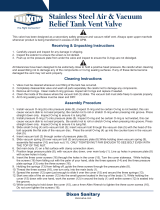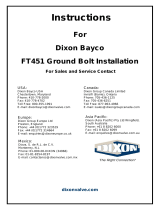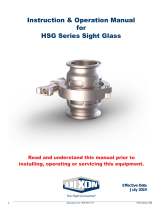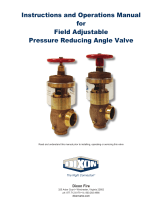Page is loading ...

Instruction & Operation Manual
for
DX60 Series Valve
Read and understand this manual prior to
installing, operating or servicing this equipment.
04/20/20

2 dixonvalve.com • 800.789.1718 DX60-Series | IOM
Table of Contents
Safety ..................................................................................................................................................................... 3
Care of Stainless-Steel ...................................................................................................................................................... 5
Technical Specifications ..................................................................................................................................................... 6
Installation and Start-Up ..................................................................................................................................................... 7
Unpacking .................................................................................................................................................................... 7
Tools Needed ............................................................................................................................................................... 7
Function Testing ......................................................................................................................................................................... 8
Orientation ................................................................................................................................................................... 8
Operation & Safety Labels ........................................................................................................................................... 9
Start-Up Cleaning ........................................................................................................................................................ 10
General Maintenance ......................................................................................................................................................... 11
Servicing Intervals ....................................................................................................................................................... 11
Lubrication ................................................................................................................................................................... 11
Inspection .................................................................................................................................................................... 12
Cleaning ....................................................................................................................................................................... 12-13
Assembly and Disassembly ............................................................................................................................................... 13
Repair Kits .......................................................................................................................................................................... 22
Bill of Materials ................................................................................................................................................................... 23
Dimensions ........................................................................................................................................................................ 25
Model Numbers and Part Numbers .................................................................................................................................... 28
Troubleshooting ................................................................................................................................................................. 29
Certifications ...................................................................................................................................................................... 30
Warranty ............................................................................................................................................................................. 31

3 dixonvalve.com • 800.789.1718 DX60-Series | IOM
Safety Information
The following DANGER, WARNING and CAUTION signs are contained in this manual. To avoid serious injury and/or possible
damage to equipment, pay attention to these messages. Hazards or unsafe practices could result in severe personal injury or death.
DANGER is used in the most extreme cases.
Hazards or unsafe practices which could result in minor or moderate injury. May also be used to alert
against an unsafe operating or maintenance practice.
Indicates a potentially hazardous situation which, if not avoided, could result in death or serious injury.
Safety logos, which appear throughout this manual, are used as a reminder that the user should carefully
review for the appropriateness of the product for the media, application and environment in which it will be
used.
Use only replacement parts and devices recommended by the manufacturer to maintain the integrity of the equipment. Make sure
the parts are properly matched to the series, model, serial number and revision level of the equipment.
Safety labels are placed on equipment where appropriate. Do not remove any labeling from any piece of equipment. Replace any
label that is missing.
DO NOT modify any Dixon product. Non-factory modifications could create hazardous conditions and void all warranties. DO
NOT attempt to use a Dixon product in any application that exceeds the product rating.
General Guidelines
• The owner must comply exclusively with these operating instructions and the authorized use of this piece of equipment. Should
problems arise that cannot be solved using these operating instructions, please contact Dixon
®
– Sanitary Division. We will be
happy to provide further assistance.
• If any modification work is performed on the product by the owner themselves, Dixon
®
shall no longer be considered the
manufacturer of the device. In such cases, all components must be subjected to a new certification process for any applicable
certifications that the equipment holds. Unless agreed to in writing by Dixon
®
, liability, warranties and guarantees shall immediately
be deemed null and void as soon as you:
o Perform modifications/conversion work on the product.
o Use the product for unauthorized purposes.
o Remove or disable safety elements.
o Process products whose material, form and size do not correspond exactly to the description provided.
o Make alterations to the original state of the device.
• The operating instructions are regarded as part of the valve.
• The operating and maintenance personnel must always be able to access the operating instructions.
• The safety instructions provided in the operating instructions must be observed.
• The operating instructions shall be valid for the entirety of the device's lifespan.
• The operating instructions must be maintained and updated as necessary.
• The operating instructions must be passed on to any subsequent owners or operators of the valve.

4 dixonvalve.com • 800.789.1718 DX60-Series | IOM
Safety Information
Owner Must Ensure
• The valve is only used as authorized in this manual.
• The valve is only used when it is in fault-free, fully functional condition, and that the safety equipment is regularly checked to
ensure that it is fully functional.
• The valve is only operated, maintained and repaired by personnel with the appropriate qualifications and authorization.
• Checks are made before the valve is put into operation to ensure that only the authorized person is in the work area, and no
one is in danger of being injured if the product is in operation.
• The valve is checked for visual damage prior to commissioning to ensure that it is only operated when free of faults.
• Any defects are reported immediately to the appropriate supervisor.
• All safety and warning notices attached to the valve or near the valve are legible and none are removed.
• The operating instructions are always kept close to the valve operation site, in a legible and complete state.
• Personnel are regularly instructed on all occupational safety and environmental protection issues, and are familiar with and
observe the operating instructions, especially the safety instructions contained herein.
• Personnel are trained and supervised to ensure that they follow safety measures, including the obligatory use of
personal protective equipment.
• The valve is only connected to pipelines that are depressurized at the time of connection.
• There is no tensile or compressive stress acting on the valve connections.
• There is no residual risk at any point where high pressure could occur. High pressure can cause sudden failure in or damage to
the lines and connections.
• Warning notices in the documentation for supplier modules are observed and integrated into the risk assessments in the
workplace.

5 dixonvalve.com • 800.789.1718 DX60-Series | IOM
Care of Stainless Steel
The stainless-steel components in Dixon Sanitary equipment are machined, welded and assembled by skilled craftsmen using
manufacturing methods that preserve the corrosion-resistant quality of the stainless-steel. Retention of corrosion-resistant qualities
under processing conditions requires regular attention to the precautions listed below.
1. Regularly check all electrical devices connected to the equipment for stray currents caused by improper
grounding, damaged insulation or other defects. Corrosion: Pitting often occurs when stray currents
encounter moist stainless-steel.
2. Never leave rubber mats, fittings, wrenches, etc. in contact with stainless-steel. Corrosion: Pitting or galvanic action. Objects
retard complete drying, preventing air from reforming the protective oxide film. Galvanic corrosion occurs when two dissimilar
metals touch when wet.
3. Immediately rinse equipment after use with warm water until the rinse water is clear. Clean the equipment (manual or CIP)
as soon as possible after rinsing. Corrosion: discoloration, deposits, pitting. Product deposits often cause pitting beneath the
particles.
4. Use only recommended cleaning compounds. Purchase chemicals from reputable and responsible chemical
manufacturers familiar with stainless-steel processing equipment they continuously check the effects of their products on
stainless-steel.
5. Use cleaning chemicals exactly as specified by the manufacturer. Do not use excessive concentrations, temperatures or
exposure times. Corrosion: Pitting, discoloration, stress cracks. Permanent damage often occurs from excessive chemical
concentrations, temperatures or exposure times.
6. For manual cleaning, use only soft non-metallic brushes, sponges or pads. Brush with the grain on polished surfaces to avoid
scratching the surface. Corrosion: Pitting, scratches. Metal brushes or sponges will scratch the surface and promote corrosion
over a period of time. Metal particles allowed to remain on a stainless-steel surface will cause pitting.
7. Use chemical bactericides exactly as prescribed by the chemical manufacturer in concurrence with the local health authority.
Use the lowest permissible concentration, temperature and exposure time possible. Flush immediately after bacterial treatment.
In no case should the solution be in contact with stainless-steel for more than 20 minutes. Corrosion: Protective film destroyed.
Chlorine and other halogen bactericides can destroy the protective film. A few degrees increase in temperature greatly increases
chemical activity and accelerates corrosion.
8. Regularly inspect the joints in pipelines. Be sure all connections are tight fitting without binding. Corrosion: Crevice corrosion.
Small crevices caused by improperly seated gaskets will promote crevice corrosion. Stainless-steel under stress will develop
stress cracking, especially in the presence of bactericides containing chlorine.
9. Regularly inspect equipment for surface corrosion (i.e. pitting deposits, stress cracks, etc.). If deposit or color corrosion is
detected, remove it immediately using mild scouring powder and detergents. Rinse thoroughly and allow to air dry. Review
production and cleaning procedures to determine the cause. Note: If corrosion is not removed, the protective film cannot be
restored, and corrosion will continue at an accelerated rate.

6 dixonvalve.com • 800.789.1718 DX60-Series | IOM
Technical Specifications
Materials of Construction Technical Data
• product contact components: 304
• non-product contact components: refer to BOM for individual component materials.
Sealing Materials Technical Data
• product contact components: 3A & FDA Grade FKM or Buna
• non-product contact components: refer to BOM for individual component materials.
Line Pressure Technical Data
• max product line pressure: 75 PSI (5.17bar)
Product Temperature Technical Data
• max operating temperature: 212°F (100°C) For higher temperatures, consult factory.
• minimum operating temperature: -20°F (-28.9°C) For lower temperatures, consult factory.
• max ambient temperature: 140°F (60°C)
Surface Finish Technical Data
• product contact components: Ra ≤ 32
• optional finishes: upon request
• non-product contact components: Ra ≤ 63
Connections
• Flange with ANSI B16.5 Class 150# Flange Bolt Circle x Sanitary Male Threaded Bevel
• 6in Sanitary Triclamp Flange x Sanitary Male Threaded Bevel
Sizes
• 3in
• 6in Triclamp x 3in Threaded Bevel
Cleaning Method
• CIP – models: sizes: DX60-Series. All Sizes.
• COP – models: sizes: DX60-Series. All Sizes.
Weight
• Valve with standard plunger and valve cover: 27.0lbs
• Valve with standard plunger and without valve cover: 24.6lbs
• Valve with freeze rod plunger and valve cover: 28.0lbs
• Valve with freeze rod plunger and without valve cover: 25.7lbs

7 dixonvalve.com • 800.789.1718 DX60-Series | IOM
Installation & Start-Up
The following should be performed upon receiving the valve and prior to installation and use of the valve. It is important that all
the following processes and procedures are carefully followed and adhered to. Dixon
®
is not responsible for any damage that
occurs during the unpacking or installation process.
Unpacking
Carefully unpack the valve and inspect each part for any damage that may have occurred during shipment. The valve is shipped
with a protective dust cover attached, so be sure to inspect the cover for any signs of damage as well as the valve itself. Report any
damage to the carrier immediately. The valve is shipped with all necessary certificates and manuals. Please add this paperwork to
the plant maintenance files for future use and reference. Additional information for the valve can be found at dixonvalve.com.
The following items should be inspected for damage:
Item #
Description
1
Bevel Seat Nut
2
Bevel Seat Cap
3
Valve Housing
4
Valve Housing Cover
Tools Needed
The following tools will be required for any maintenance of the valve:
• Item 1: Hammer
• Item 2: 5/16” Allen Tool
• Item 3: Punch
• Item 4: 7/16” Box Wrench
• Item 5: Jax PURgel KLEAR®
• Item 6: O-Ring Pick
• Item 7: Liquid Thread Locker (Not Shown)
1
2
3
4
5
6

8 dixonvalve.com • 800.789.1718 DX60-Series | IOM
Installation & Start-Up
Function Testing
• Check visually to ensure that the equipment is not leaking.
• Any defective seal that could have been damaged during disassembly or assembly must be replaced.
• Check all equipment components for any signs of damage and replace damaged components.
• Ensure that all bolts and clamps are securely tightened.
• Ensure that any pneumatic hose connections are free of leaks if applicable.
• Confirm all pipes and fittings connected to the equipment permitted for use are in the intended pressure range.
• Check that the maximum pressure indicated on the equipment or in the specifications section of this manual has been complied
with.
Installation Orientation
Equipment must be installed in the proper orientation to ensure proper functionality and cleanability. Please refer to the following
diagrams below for proper installation.
IMPORTANT: The valve must be installed with the outlet port facing downward if the valve is going to be cleaned-in-place (CIP’d). If
the valve is installed with the outlet port in any other orientation other than what is depicted in Figure 1, the valve must be cleaned-out-
of-place (COP’d) in a COP tank.
Figure 1 – Installation Orientation

9 dixonvalve.com • 800.789.1718 DX60-Series | IOM
Operation & Safety Labels
IMPORTANT: Each valve is supplied with operation
instructions in the form of a 5in X 7in weatherproof sticker that
must be installed on the back of the trailer so that the sticker can
be clearly seen while operating the valve. This sticker is provided
in both English & Spanish. Figure 2 shows an example of how
the sticker should be placed on the trailer. Alternately, the sticker
could be placed below or to the side of the valve, but it MUST be
visible. Should the sticker degrade over time to the point that it is
no longer readable, replace the sticker immediately. The sticker
part number can be found in the BOM section of this manual.
Sticker Technical Specifications
- Total Thickness
0.0073in ±10%
- Adhesive Type
Solvent Acrylic
- Min. Application Temperature
+45°F
- Service Temperature Range
-40°F to +300°F
- Typical Service Life
5 Years
- Peel Adhesion (Stainless)
4.2 lbs.
Figure 2 – Sticker Location
Figure 3 – Sticker Example

10 dixonvalve.com • 800.789.1718 DX60-Series | IOM
Cleaning
IMPORTANT: Before operating the equipment during formal production, please follow the guidelines listed below to ensure that your
equipment is clean and ready for service.
• Ensure that the equipment is installed in a proper orientation to allow the equipment to be cleaned and drained properly.
Reference the installation and startup section of the manual for orientation guidelines.
• Flush the equipment with an appropriate cleaning agent to remove any residue that may be on the equipment from shipping.
IMPORTANT: DO NOT use cleaning agents that will attack stainless-steel or the elastomers that were supplied with the valve. If
you are unsure what elastomer is used in the valve, reference the part number key in this manual to make the determination.
• Follow any MSDS instructions for proper use or handling of cleaning agents.
• Flush the equipment sufficiently to remove any soiling from the product contact components. Depending on the process, there
may be varying amounts of soiling. Cleaning times and cleaning agent concentrations will vary depending on the product being
processed. It is the responsibility of the operator to determine and adjust these cleaning specifications as necessary.
• The equipment should not be allowed to sit with product present in it for extended periods of time. Equipment should be cleaned
immediately after processing is complete.

11 dixonvalve.com • 800.789.1718 DX60-Series | IOM
General Maintenance
To ensure proper operation of your Dixon
®
valve, proper maintenance must be performed at regular intervals. To prevent damage,
check all fitting connections and screw connections for any loosening of the connections during equipment operation. Maintain
adequate spare parts stock for all replacement components on the piece of equipment. Please refer to the repair kits section of the
manual for complete component part numbers and kit part numbers.
Servicing Intervals
Recommended intervals for one shift operation would be 3 months. However, only the user/owner can determine the appropriate
service intervals as the length between service intervals is dependent on the following parameters:
• duration of use per day – number of cycles
• type of product
• product temperature
• product viscosity
• cleaning agent
• type of cleaning (CIP/COP)
Lubrication
Please use the following chart below for proper grease type for varying component materials. DO NOT use mineral or animal-
product-based greases. Check all visible seals for any signs of damage and replace as necessary. For sliding surfaces, use Jax
®
PurGel Klear food grade grease. If a different grease is used other than what is specified in this manual, there is risk of damaging the
seals. Lubrication is only required when the equipment is being reassembled after servicing.
Seal Material
Grease Type
FKM
JAX
®
PurGel Klear
BUNA
JAX
®
PurGel Klear
PTFE
Do Not Grease

12 dixonvalve.com • 800.789.1718 DX60-Series | IOM
General Maintenance
Inspection
Inspection of the components listed below should be done during regular servicing intervals. Before removing the valve from the
trailer, please take care to do the following:
• Clean the trailer completely to remove any product that may be harmful if contacting a person.
• Drain the trailer completely that connects to the valve being serviced.
• Make sure the valve is completely free of any product before removing from the trailer.
• Once the valve has been removed from the trailer, cover the outlet of the trailer with a clean cotton rag to prevent any foreign
material from entering the trailer.
Components to be inspected (Refer to BOM Section of the manual):
• Lip Seal (Item No. 6)
• Plunger Seal (Item No. 8)
• Bonnet Seal (Item No. 9)
• Plunger (Item No. 4)
• Bonnet (Item No. 3)
• Valve Housing (Item No. 1)
Any components that show signs of severe wear or damage should be replaced during the scheduled maintenance time for the
equipment. Please refer to the assembly and disassembly section of this manual for proper instructions on removing and replacing
any worn or damaged components. Replacement components and repair kits can be found in the BOM or repair kits section of this
manual.
Manual Cleaning (COP)
1. Refer to the disassembly section of the manual and follow instructions to remove all product contact components.
2. Inspect the product contact components of the equipment for any signs of possible damage. Replace components as necessary.
(See the equipment BOM in this manual for replacement component part numbers.)
3. Clean all surfaces of the product contact components by manually brushing in a bath of cleaning solution (acid detergents or
simple alkaline soda type detergents).
4. After cleaning, rinse all components thoroughly with water.
5. Refer to the assembly section of the manual and follow instructions to properly reassemble the equipment.
Cleaning in Place (CIP)
Note: Not all models or sizes may be certified for CIP. Please check the specifications section of the manual to determine what
cleaning method is suitable.
1. Regularly flush the valve with a suitable medium to preserve seals and integrity of the product contact surfaces, such as when
there is a product changeover or downtime. These intervals shall be determined by the end user.
2. Important: Only use cleaning agents which will not harm the seals and stainless-steel.
3. Follow any MSDS instructions for proper use or handling of cleaning agents.
4. The necessary cleaning times, temperatures and cleaning agents will depend on the degree of contamination and must
be adapted accordingly.
5. Cleaning flow velocities of 5-6 ft/s should be maintained for proper cleaning of the equipment.
6. The valve plunger must be cycled between the “open” and “closed” positions during the CIP cleaning process to ensure that all
product contact surfaces are properly exposed to the cleaning fluid. (See diagram)

13 dixonvalve.com • 800.789.1718 DX60-Series | IOM
7. After cleaning, rinse the equipment thoroughly with water.
Assembly and Disassembly
To ensure quality operation of your Dixon
®
equipment, the equipment must be disassembled and assembled properly to prevent
equipment damage during operation. Please follow the instructions contained in this manual carefully and be sure to follow any safety
warnings contained herein. If any questions should arise during the assembly or disassembly process that are not addressed in this
manual, please feel free to contact Dixon
®
– Sanitary Division at 800.789.1718.
Assembly
1. Grease the plunger seal O-Ring DX60-PS-V-30 with
food grade grease install the plunger seal O-Ring onto
the plunger DX60-PL-30 by pressing the O-Ring firmly
into the O-Ring groove of the plunger. Press evenly
around the diameter of the O-Ring to ensure that the O-
Ring is sitting firmly in the groove.
Closed Position
Open Position
Pull Open
Push Close

14 dixonvalve.com • 800.789.1718 DX60-Series | IOM
2. Grease the bonnet seal O-Ring DX60-PS-V-30 and the
lip seal DX60-LS-V-30 with food grade grease. Install the
bonnet seal O-Ring on the bonnet by pressing the O-
Ring firmly into the O-Ring groove of the bonnet being
careful not to roll the O-Ring.
3. Grease the bonnet lip seal DX60-LS-V-30 liberally with
food grade grease. Install the lip seal into the gland in
the bonnet and press firmly into place. Pinching the lip
seal will help to fit the seal into the gland groove. Ensure
the seal is sitting securely in the bonnet and that there
are no gaps between the lip seal and the bonnet face.
Bonnet Cross Section
There should be no large
gaps between the stainless &
the rubber.

15 dixonvalve.com • 800.789.1718 DX60-Series | IOM
Assembly
4. Insert the plunger DX60-PL-30 carefully through the lip
seal and bonnet. Check the lip seal to ensure that it was
not damaged in any way.
5. Install stem bushing DX60-SB-30 onto the plunger stem
and slide bushing down until it contacts the bonnet
securely.

16 dixonvalve.com • 800.789.1718 DX60-Series | IOM
Assembly
6. Install bonnet hub flange DX60-BF-30 by sliding it onto
the plunger stem and pressing down until it contacts the
bonnet. Align the clearance holes in the bonnet hub
flange with the threaded holes in the bonnet. Insert the
bonnet hub flange bolts DX60-BFHB-30 through the
clearance holes and tighten the bolts to 75in-lb. Note:
apply thread locker to the bolts.
7. Install the handle DX60-HA-30 onto the plunger stem
being sure to line up the machined flat on the handle
with the machined flat on the plunger stem. See diagram
below. Apply thread locker to the plunger handle bolt
DX60-HAB-30 & tighten using a 5/16” Allen.

17 dixonvalve.com • 800.789.1718 DX60-Series | IOM
Assembly
8. Insert the plunger/bonnet/handle assembly into the valve
housing making sure to align the bonnet locating pin with
the notch in the valve housing. Install the body clamp
DX60-CLMP-30 and tighten the wing nut securely.
Disassembly
1. Remove plunger handle bolt DX60-HAB-30 using a
5/16” Allen tool and then remove handle DX60-HA-30.

18 dixonvalve.com • 800.789.1718 DX60-Series | IOM
2. Remove body clamp DX60-CLMP-30 by loosening the
wing nut with your hand. Remove the plunger & bonnet
assembly from the valve body DX60-BDY-30.
3. Remove the plunger DX60-PL-30 from the valve bonnet
DX60-BON-30 and inspect for any signs of damage.
Replace any components as necessary

19 dixonvalve.com • 800.789.1718 DX60-Series | IOM
4. Remove the bonnet flange bolts DX60-BFHB-30 from
the bonnet hub flange DX60-BF-30 using a 7/16” box
wrench. Remove the bonnet hub flange from the bonnet
DX60-BON-30.
5. Remove the stem bushing DX60-SB-30 from the bonnet
hub flange DX60-BF-30.

20 dixonvalve.com • 800.789.1718 DX60-Series | IOM
5a. Using a punch tool and hammer, knock out the handle
pins G100HRP from the bonnet hub flange.
Note: Handle cam arms G100HR only require
disassembly if arms are damaged or worn and
require replacement.
5b. Remove handle pins G100HRP and handle cam arms
G100HR from bonnet hub flange DX60-BF-30.
/













